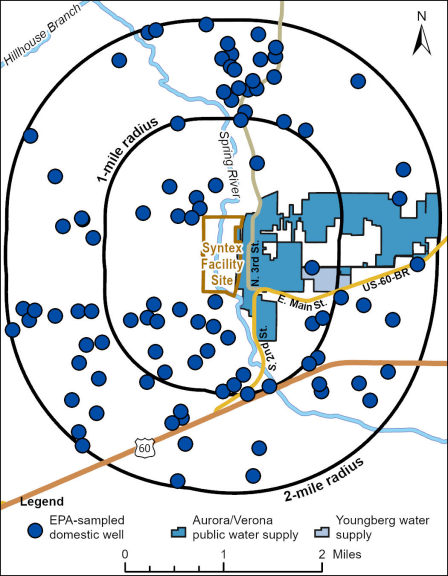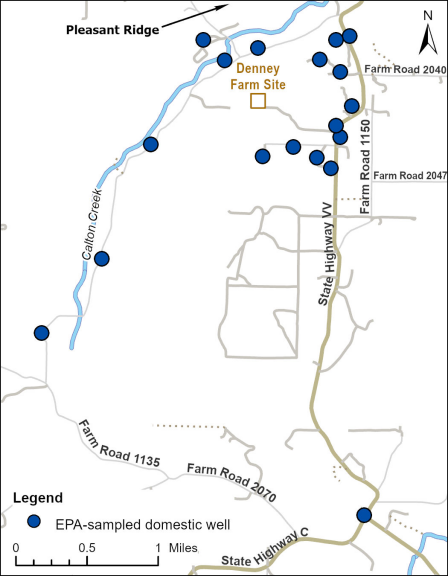Syntex Facility National Priorities List (NPL) Superfund Site, Verona, Lawrence County, Missouri - Fact Sheet, December 2020
Site Update – Completion of Private Well Testing
- Summary
- Site Overview
- Domestic Well Survey and Sampling
- Ongoing Site Investigations
- Next Steps and Technical Assistance
- Additional Resources and EPA Contacts
Testing of domestic water wells surrounding the Syntex Facility National Priorities List (NPL) Superfund Site (site) and near the Denney Farm site has been completed. Responding to community concerns voiced in 2019, and current site conditions, the U.S. Environmental Protection Agency (EPA) Region 7 sampled over 105 private, domestic drinking water wells for site-related contaminants; none of these results were above the relevant EPA health-based standards. This Fact Sheet provides an overview of this domestic well sampling effort. EPA continues to oversee ongoing site investigations to evaluate the overall protectiveness of historic remedial actions.
For additional information on the site history, contaminants of concern, and the results of recent investigations, see the Supplemental Information addendum to this Fact Sheet.
The Syntex Facility Site covers approximately 180 acres and is located at 299 Extension Street in Verona, Lawrence County, Missouri. The Spring River passes through the site, dividing it into two areas – the approximately 100-acre East Area and the 80-acre West Area. The East Area is within the floodplain of the Spring River and includes buildings and infrastructure associated with former and current manufacturing facilities. The West Area is a mostly wooded, rolling upland terrain. The eastern portion of the former Syntex facility is now owned and operated by BCP Ingredients Inc.
Before industrial operations, the site was used for agricultural and recreational purposes. In the 1960s, Hoffman-Taff Inc. owned and operated the facility. Hoffman-Taff produced 2,4,5-trichlorophenoxy-acetic acid (also known as 2,4,5-T) for the U.S. Army. 2,4,5-T is one component of the defoliant commonly referred to as Agent Orange.
In 1969, Hoffman-Taff leased a portion of the facility to Northeastern Pharmaceutical and Chemical Company (NEPACCO) for the production of hexachlorophene, which at one time was a widely used antibacterial agent. NEPACCO manufactured pharmaceutical-grade hexachlorophene until 1972, when the U.S. Food and Drug Administration imposed strict limits on its use in over-the-counter products and market demand decreased. In December 1969, Syntex purchased the facility from Hoffman-Taff and allowed NEPACCO’s lease to remain in effect.
Dioxin (2,3,7,8-tetrachlorodibenzo-p-dioxin), also known as or 2,3,7,8-TCDD, was created as an unwanted byproduct in the production of 2,4,5-T and hexachlorophene. Chemical manufacturing waste residues were disposed of in several areas at the facility, contaminating the soil and groundwater with dioxin and volatile organic compounds (VOCs). Fish and sediment in the downstream Spring River were also contaminated. (See more about dioxin under Additional Resources.)
Dioxin, a persistent organic pollutant, is considered by EPA to be an extremely toxic contaminant. Chlorinated dibenzo-p-dioxins (CDDs) are a family of 75 chemically related compounds, commonly known as chlorinated dioxins. One of these compounds is 2,3,7,8-TCDD. It is one of the most toxic of the CDDs and the one most studied.
Since 1980, federal and Potentially Responsible Party (PRP) actions have been taken to assess and address contamination at the site. Between 1988 and 1990, dioxin-contaminated soils were excavated and incinerated. These areas have been reassessed recently and found to be acceptable for industrial use. For a summary of previous and ongoing actions, see the Supplemental Information addendum.
DOMESTIC WELL SURVEY AND SAMPLING
In 2019, EPA held two public availability sessions and participated in an open city council meeting to provide updates to the community about ongoing site activities being performed by Syntex under a 2016 Administrative Order on Consent (AOC) with EPA.
EPA initiated the large-scale, domestic drinking water well sampling program in 2019 in response to recent investigations that identified 1,4-dioxane in the groundwater at the site and the public’s concern that site contaminants might be present in their domestic drinking water wells. 1,4-dioxane is soluble in water and does not readily biodegrade in the environment. With participation from the public, EPA sampled and assessed the water quality of domestic wells at residences within 2-miles of the Syntex Facility site and near the Denney Farm Site. (See more about 1,4-dioxane under Additional Resources.)
Domestic Wells Near the Syntex Facility Site
 Figure 1 – Private domestic wells sampled near the Syntex Facility Site.EPA performed an extensive survey of domestic wells within 2 miles of the site boundary, using public records of domestic wells and property ownership plus information provided by interested domestic well owners. In December 2019 and January 2020, EPA sampled over 90 domestic wells (serving residences, a business, and a church) in the area around the site. Figure 1 at right illustrates the distribution of domestic wells sampled. EPA analyzed the water samples for 1,4-dioxane, as well as other semi-volatile organic compounds (SVOCs), VOCs, dioxins, and dioxin-like compounds (DLCs). EPA also sampled one small public water supply for 1,4-dioxane. The contaminant 1,4-dioxane was not detected in 89 of the domestic wells; however, it was detected at low levels in one domestic well.
Figure 1 – Private domestic wells sampled near the Syntex Facility Site.EPA performed an extensive survey of domestic wells within 2 miles of the site boundary, using public records of domestic wells and property ownership plus information provided by interested domestic well owners. In December 2019 and January 2020, EPA sampled over 90 domestic wells (serving residences, a business, and a church) in the area around the site. Figure 1 at right illustrates the distribution of domestic wells sampled. EPA analyzed the water samples for 1,4-dioxane, as well as other semi-volatile organic compounds (SVOCs), VOCs, dioxins, and dioxin-like compounds (DLCs). EPA also sampled one small public water supply for 1,4-dioxane. The contaminant 1,4-dioxane was not detected in 89 of the domestic wells; however, it was detected at low levels in one domestic well.
None of the domestic wells were found to be impacted by site-related contaminants above the relevant EPA health-based standards.
Denney Farm Site Overview
The Denney Farm site is located on the former 160-acre Denney Farm in Barry County, approximately 7 miles south of Verona, Missouri. In 1971, NEPACCO disposed of 80 to 90 drums of still bottoms and other refinery wastes on this property in a shallow trench approximately 10 feet wide and 60 feet long. The wastes contained dioxin. Note: This trench is separate from the “Trench Area” at the Syntex Facility Site (as outlined in the Supplemental Information addendum).
In early investigations at the Denney Farm in 1980, EPA assessed groundwater quality in the area by collecting 115 samples from 14 nearby domestic wells and a spring. None of the samples were found to contain dioxin.
Syntex, working under the terms of a 1980 Consent Decree with EPA, excavated the drums and soils in the trench in June and July 1981. Syntex excavated an additional 5 to 12 inches of soil from the sides and bottom of the trench. The soils in the trench bottom and sidewalls were sampled. Dioxin concentrations generally decreased outward from the sidewall and downward from the trench bottom. At most, an estimated 0.38 ounces of dioxin remained at depth. EPA determined that additional excavation was not necessary, since the remaining dioxin was considered immobile and the area could be capped and maintained to prevent soil exposures from occuring. Capping was completed in December 1981.
Denney Farm Site and Nearby Domestic Wells
 Figure 2 – Private domestic wells sampled near the Denney Farm site.During EPA’s meetings described above, the public also expressed concern about potential impacts from the nearby Denney Farm site to domestic wells. Dioxin, unlike 1,4-dioxane, adheres well to soil (if released to land), is relatively insoluble in water, and is not likely to leach to groundwater.
Figure 2 – Private domestic wells sampled near the Denney Farm site.During EPA’s meetings described above, the public also expressed concern about potential impacts from the nearby Denney Farm site to domestic wells. Dioxin, unlike 1,4-dioxane, adheres well to soil (if released to land), is relatively insoluble in water, and is not likely to leach to groundwater.
In December 2019 and February 2020, EPA sampled 18 domestic wells in the vicinity of the former Denney Farm site. The water samples were analyzed for SVOCs including 1,4-dioxane, VOCs and dioxins. Figure 2 at right illustrates the locations of the domestic wells that were sampled. None of the private wells sampled near the Denney Farm site were found to be impacted by site-related contaminants above the relevant EPA health-based standards.
ONGOING SYNTEX SITE INVESTIGATIONS
In 2017, with oversight from EPA, the PRP began conducting the additional site characterization and risk assessment activities described in the 2016 AOC. For a synopsis of assessment activities performed to date at the four study areas (Spring River sediment, East Area Surface Soils, Trench Area, and East Area Groundwater), see the Supplemental Information addendum.
On Jan. 9, 2019, an Environmental Covenant covering the East Area of the Syntex Facility Site went into effect. The Covenant assures that any future activities causing the soil to be disturbed or excavated will be conducted in a manner that is protective of human health and the environment.
The Covenant also requires the property owner to sample and assess the soils for dioxin and dioxin-related compounds, as well as polychlorinated biphenyls (also known as PCBs), prior to disturbance or excavation; and requires proper maintenance of asphalt and concrete-covered areas. Additionally, the Covenant prevents groundwater use at the site.
EPA continues to conduct regular checkups, called Five-Year Reviews (FYRs), at certain Superfund sites where cleanups have been completed, including the Syntex Facility Site. Questions were raised in the site’s FYRs (from 2012 and 2017) regarding the protectiveness of the historical remedies. The FYRs concluded that EPA had insufficient information to evaluate the overall protectiveness of historic remedial actions due to data gaps. However, the work performed since both FYRs has provided answers to most of the questions raised. EPA will continue to oversee the work being performed by the PRP to satisfy the requirements of the AOC and address data gaps. This work will continue until the remaining questions can be resolved.
Once the work is complete, EPA will have the necessary information to evaluate the remedy protectiveness of human health and the environment. As more information becomes available, EPA will provide updates regarding the work being performed.
TECHNICAL ASSISTANCE OPPORTUNITIES
To help affected communities understand the technical information related to a Superfund site, and provide more opportunities for the public to participate in cleanup decisions, EPA has established technical assistance programs. For instance, through the Technical Assistance for Communities (TASC) program, communities can request an independent TASC advisor to assist citizens in their interpretation of technical data used to support site actions; understand site hazards; and become more knowledgeable about different technologies used to clean up sites. In addition, EPA's Technical Assistance Grant (TAG) program provides up to $50,000 for a qualified citizens’ group (nonprofit) to apply for a TAG to hire an independent technical advisor. Please contact EPA for more information.
-
Site Profile Page (see Site Documents & Data)
- EPA Fact Sheets for Missouri cleanups
- Nov. 2019 Fact Sheet and site background
- Information regarding FYRs
About the Contamination
For additional information about site-related contaminants and public health risks, visit:
EPA CONTACT INFORMATION
EPA and the state encourage members of the community to ask questions and report any concerns about the site. If you have questions about this fact sheet, need additional information, and/or would like to receive site updates, please contact EPA:
Lenexa, KS 66219
Email: houston.pamela@epa.gov
Lenexa, KS 66219
